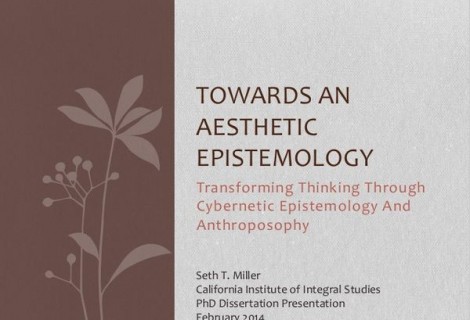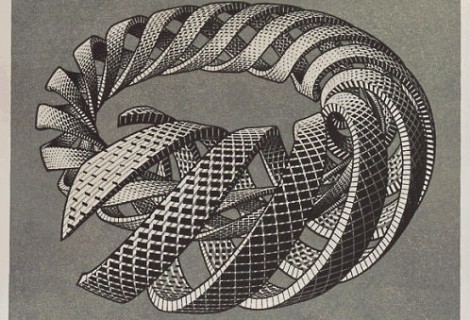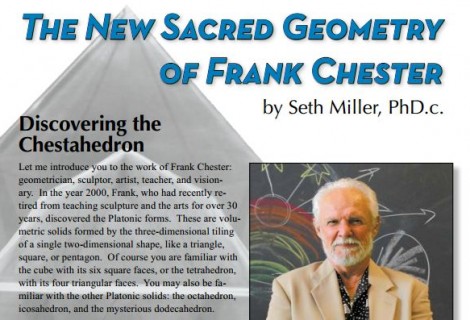An Esoteric Guide to Spencer Brown’s Laws of Form #2
« Previous Page | 1 2 3 4 | View All | Next Page »
(New readers will want to start with the first installment.)
Let us continue our beginning:
LoF p. 1
- We take as given the idea of distinction and the idea of indication, and that we cannot make an indication without drawing a distinction. We take, therefore, the form of distinction for the form.
If this doesn’t strike you as having a “mystical” flavor, then you are drinking the wrong concoction. I’m not going to try to explain this, but rather I’m going to try to re-frame it; you could say, in GSB-approved language, that I’m going to re-mark it. The important thing to note about this, the very first “official” sentence of the LoF, is that it is recursive. Let’s be clear: the Laws of Form (not the book, the LAWS) are only possible because of a recursion, a throwing back on itself of itself. But a throwing back of what onto itself?
Well, “nothing”, of course; but nothing understood as what everything would be if it were.
But of course nothing doesn’t remain nothing (well, it does, but it doesn’t), because here we are. The question GSB is really attempting to get at is the question: how does this nothing become “all this”? THAT it does is directly evident (to the “all this” and likewise “all of us”), but GSB wants to know how; he wants to know the form by which happening happens.
There is only, really, one option: nothing becomes “all this” by virtue of a distinction.
Now, you’ll have to stay close as we proceed on this journey, because what we are doing here is trying to illuminate not creation, but the illumination that illuminates creation. We are trying to describe not simply what can possibly be talked about (the “all this”), but are attempting, rather, to describe describing. At its heart, this is ultimately an esoteric task, not a philosophical one.
So to begin: the first distinction is THAT OF distinction. As we find out in the very last sentence of the last “official” chapter (before the lengthy notes),
LoF p. 76
- “We see now that the first distinction, the mark, and the observer are not only interchangeable, but, in the form, identical.”
This is to say, the distinction and the distinguisher are equivalent (they are confused, fused together). You may be wondering what “the mark” is. GSB just said it was identical with the first distinction, but while this is true, it is not yet illuminating. GSB uses the idea of a mark in its literal sense, as a mark on a page, for example. For this reason he can say
LoF p. 4
- Let a state distinguished by the distinction be marked with a mark [see below] of distinction.
The actual mark can be anything, but he uses the shape of a capital T with the right hand limb missing, an upside-down and backwards “L”. In other words, making a distinction leaves a mark, and we can indicate the mark in any way we choose (we can mark the mark), but we have to choose something.
So back to the first distinction. What is it? The first possible distinction is that OF distinction, BY an observer which is the same as that distinction. Got that? It should be exquisitely clear that recursion is the nature of the form, and that this could not be otherwise.
So we have a complex unity of the beginning of everything, consisting simultaneously of:
- the fact of distinction as the only possible form for the form
- the fact that the form of the form is recursive (what the form distinguishes is itself)
- the fact that this “itself” is the same as the observer making the distinction.
The esoteric point is that these three aspects are all co-incident: they are the same incident, that of creation (all creation, not just the beginning of the beginning). What I would like to point out is that this recursion has a special character that becomes a key element in understanding all that flows from this beginning, and it has to do with the difference between “levels of order” N and N+1.
But before I use this difference to make a difference, we need a reason to make the difference. In GSB’s words,
LoF p. 1
- There can be no distinction without motive, and there can be no motive unless contents are seen to differ in value.
In other words, there can be no distinction without a motive to distinguish, but there can be no motive except by virtue of a distinction.
Thus (in a circle):
motive–>distinction–>(value)–>motive–>…
The whole is recursive. But here, Ranulph Glanville, President of the American Society for Cybernetics, points out that
“If everything depends on drawing a distinction, how is the mark separated from the value? It must be distinguished. Then, if it is distinguished, it is distinguished by another mark (and value) drawn… ad infinitum. Unless the mark is the value, the value is the mark—ie, unless there is no space (that is to be cleaved), and the distinction drawn distinguishes only itself. (In geometric analogy, instead of the distinction taking the form of a circle, it takes the form of a Möbius strip—that, from above, looks like a circle—which contains no space, has no in and outside, and which, having only one surface, can have its own value on itself: the mark is the value, the value is the mark.)” (Glanville, The Cybernetics of Value and the Value of Cybernetics; The art of Invariance and the Invariance of Art. Et Cetera, p. 3-4).
Perhaps you can thus see the problem which GSB himself did not note. Drawing a distinction is not a singular act; it has at least a dual character, because there is the act of making the distinction (making the mark), and there is the distinction made (the value indicated by the mark). The problem is that GSB’s formulation the first distinction doesn’t distinguish between the mark as an ACT and the mark as a VALUE, but it must somehow if we are to get anywhere. The way to do this successfully is with the implementation the idea of N and N+1 levels of order. Soon.
As GSB indicates,
LoF p. 3
- What is not allowed is forbidden.
This is to say that we can only use distinctions that we make; therefore we must complexify our understanding of the first distinction: we must distinguish anew the first distinction. Glanville, with Francisco Varela, recognized this problem. They saw that it led to an infinite regress (the bane of logic, which we are supposed to avoid), and their solution was to say that “distinction cannot cleave a space, and its value must not be distinct from its mark, that is, a distinction distinguishes (is) itself.” (Glanville, The Self and the Other: The Purpose of Distinction p. 1).
Yet he notes that that the distinction, which only distinguishes itself, also implies a manifold. Actually, we see that distinction must imply a manifold (it cannot ONLY be itself distinguishing itself, simply) or existence would never have any content other than existence itself — that is, no distinction of difference beyond that of the fact that existence exists.
Thus the first distinction must be a complex distinction; it must, we could say, keep the Chaos alive, it must maintain potential in more than one way. This is to say that it must be a complex unity, a single diverse manifold.
Now we have noted that Glanville wants to say that in order to avoid an infinite regress of distinctions that never reach any value, the distinction must distinguish only itself. But we can point out that this does not actually solve the problem, it rather only is a viewing of the problem from a different perspective. He thus ends up saying that:
“If, in drawing a distinction, we do not distinguish between the mark and the value but take the value as being the mark, we have no regress. The distinction is then a self-distinction, and the value (which is the mark) is the value to the self. It is not accessible to the outsider. It remains private. We have, instead, Objects that distinguish themselves and do not cleave a space: they do not even need a space within or without. Thus, the Object (its self itself) maintains itself, but is alone. The Object is the Object is the Object” (The Cybernetics of Value… p. 5).
This is a view which is in direct contradiction to esoteric experience… but such is not the basis upon which we need to address Glanville’s idea. We can rather point out that his attempt to avoid a regress actually fails, in the sense that the regress is successfully eliminated. It is, rather, simply transformed into a recursion, which still has a ‘regressive’ nature. However, that nature is, instead of played out extensively, is played out intensively, as in a point rather than a line.
And now we can bring back in the geometric imagination from earlier, and make use of it. Geometrically, the analogy for a normal regression is that of an infinite line. But every line is ALSO a circle whose center is at infinity. One can contract that circle (the line) from infinity (extensive space / no space) into finite (intermediate / actual) space, and then contract it further until the circle becomes a point (intensive space / no space). In other words, Glanville’s choice to avoid regress is, in some sense, unnecessary; the point-like logic is a transformation of the line-like logic, through the logic of the circle. Thus we are not restricted to our interpretation of the mark, of distinction, as that which EITHER does or does not “cleave a space”: it BOTH cleaves a space and DOES NOT cleave a space, depending upon the distinction of the distinctions. That is to say, by distinguishing the original logic of the mark of GSB from the modified “möbius logic”, Glanville is led to a lower order content (the value of the distinction), whereby “the Object is the Object is the Object” is considered as a mark marking itself in a way that is inaccessible to any outsider. But this is only a part of the story that is given by the distinction between the logic of the line and the logic of the möbius, which is the logic of the intensive point. By exploring the logic of this intensive point, we can change the way we distinguish distinction.
We have seen that the infinite regress seemed to be required by the failure of the mark to distinguish itself from its value. But to try to solve this by saying that the mark ONLY marks itself, and is thus its own value, is an error. If a mark can only mark itself, it is equivalent to being valueless, even to itself, because in order for the mark to have the value OF itself FOR itself, the mark must again distinguish itself from its value, otherwise we can only say “mark” or “value”, but not both. And here is where we get, as promised, to the need to introduce the N and N+1 business referred to before, as it provides a way to think about this admittedly bizarre and obtuse problem in a way that may continue in our quest to illuminate illumination.
To recap: we are in a position where we recognize that the mark, the first distinction, cannot be simple. It cannot mark itself only as a mark, or only as a value. It must somehow be able to mark itself and its value simultaneously without requiring an infinite number of further marks to mark that distinction. It must be able to, in a single stroke, include the possibility for endless variation without itself requiring endlessness for it to begin. The universe is; it has come to be; the mark is made, and made again, and again…
Now, the key is to recognize that the key to the treasure is the treasure. The confusion (between the mark and its value) that has arisen needs to be de-fused, and re-fused, in a new way. What needs to be de-fused is actually manifest in things we have already run across: it showed up in the distinction between the capacity to see and what is seen, between form and content, and yes, between the mark and its value. What connects these examples is itself a form, but it is also a content, and yes, the content of the form is the form, but it is a particular form; it is complex, and it is recursive, and it is the nature of the complex recursivity that distinguishes it from “mere” distinction.
Let me be clear by saying that there is no real problem with GSB’s Laws of Form; there is, however, a problem because of the way that the form is taken. This is something GSB is very sensitive to, and which he discusses in the Esalen conference (session one): we must interpret the form, but the form is not boundable by interpretation. We can interpret it any way we wish, but (as we have seen) this does not mean all interpretations have the same value, or are therefore valueless. The whole key is to recognize the difference between the form and its interpretation, because this is exactly the form, it is the key.
We can say: the form is that form whose content is the form.
This would be more exact, but it is likely not helpful, even at this point where it might be approaching some semblance of sensibility.
Let us rather say: the first distinction, which must be a distinction, must distinguish itself as the distinction between its form and its content. We can see that there are two levels at work in this form. There is the level at which the activity of the distinction is occurring, and there is the level at which the content is distinguished by that activity. We can call the level of the content level N, and the level of the activity N+1. We could also call it N-1, both are equally appropriate. The point is that the first distinction has this strange feature: it distinguishes a boundary between form and content, between the activity of distinguishing and what is distinguished, and it crosses that boundary as a part of its activity.
This is to say, the first distinction is that which distinguishes activity and content, but which does not merely distinguish them: it bridges them. The confusion pointed out by Glanville is completely valid, but it is resolvable… that is to say, it is capable of dissolution and resolution. The way to do this involves distinguishing the level of form from the level of content, and recognizing that a recursion between these levels is the form. It is a complex unity. It is not simply distinction of distinction, at least considered in the way that such a phrase is most likely to be read. Rather, it is distinction of distinction, but in the way in which the first instance of distinction exemplifies the level of activity and the second instance of distinction exemplifies the level of content. This should now be quite clear: the first distinction must be of distinction, but this must be considered as a complex, recursive creation and simultaneous crossing of a boundary that is just precisely the boundary between that very activity of its creation and the fact of it as created.







amazing…like you! thank you for sharing
Seth, this is so cool! Thanks for sharing it with us…..